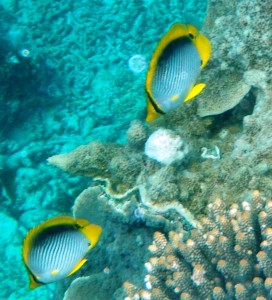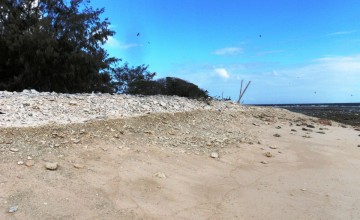A few weeks ago, I took a trip to Lady Elliot Island at the extreme southern end of the Great Barrier Reef (GBR) about 80 km off the Queensland, Australia, coast. Lady Elliot Island is a coral “cay island”; a small, low elevation, sand island on top of a coral reef.

A pair of black-back butterfly fish, Chaetodon melannotus. Photo by Rick Taylor.
A few weeks ago, I took a trip to Lady Elliot Island at the extreme southern end of the Great Barrier Reef (GBR) about 80 km off the Queensland, Australia, coast.

A lined surgeonfish, Acanthurus lineatus. Photo by Rick Taylor.

A six-bar wrasse, Thalasoma hardwicke. Photo by Rick Taylor.
Lady Elliot Island is a coral “cay island”; a small, low elevation, sand island on top of a coral reef. Lady Elliot Island is round and less than 1 km wide in any direction and you can walk all around it in about 40 min. The island formed about 5,000 years ago when the reef first broke the surface of the sea and the sand is composed almost entirely of dead and eroded coral. Still, it is just big enough to sustain Pisonia trees and various shrubs.
There are about 1,500 species of fishes recorded from the GBR and it seemed like I saw almost all of them while underwater at Lady Elliot Island! The biggest thrills for me were being next to a huge (at least 20,000 individuals) “bait-ball” of anchovies while big trevally and white-tipped reef sharks (at least four) took turns gorging on them, seeing a large barracuda (at least 1.5 m long) cruise in front of me at the lagoon snorkel site, and, of course, the many anemone fish. The reefs around the island also have good numbers of green turtles and loggerhead turtles. In fact, it was the nesting season for green turtles and a walk around the island at 2:30 AM revealed many fresh tracks and nest sites.

Black noddys, Anous minutus. Photo by Rick Taylor.

The beach at Lady Elliot Island showing dead coral in various stages of erosion that forms the beach. Photo by Rick Taylor.
Also, it was nesting time for many sea birds; black noddy and bridled terns were very abundant, as were wedge-tailed shearwaters, buff-banded rails, reef egrets, and a silvereye or two. In fact, Lady Elliot Island is reported to have the greatest diversity of sea birds in the GBR and the cacophony of nesting birds never ends (some folks used earplugs!). The smell of guano and the relentlessly pounding surf were great sounds and sites to wake up to. Interestingly, the Lady Elliot “Resort” is quite a simple affair that runs on solar power and has its own desalinization plant to provide fresh water.
Still, the most amazing thing about the reef at Lady Elliot Island was, well, the coral. From the dozens of species that, indeed, resemble an underwater garden and provide habitat for thousands of fishes to the fact that the island itself is composed of dead coral that has been eroded to various degrees, the coral assemblages define the very term “keystone species” – a species (or, in this case, a group of species) around which a whole ecosystem turns.
